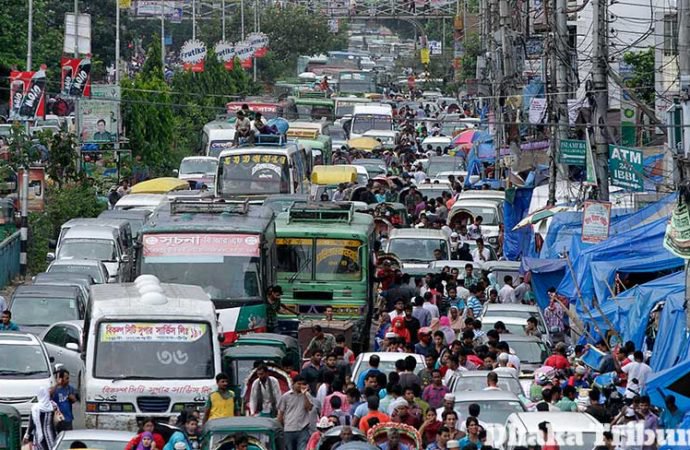Traffic jam in Dhaka
Despite the construction of several flyovers, allowing people to park their vehicles on designated streets and bus stops, and stern action against wrong-side driving, traffic congestion in Dhaka continues to aggravate, causing serious sufferings to city commuters.
According to Dhaka Metropolitan Police (DMP) Traffic Department, traffic jam has become intolerable over the last few days in some city areas, including Mirpur-12 to Mirpur-10 crossing, Rokeya Sarani, Gulshan, Banani, Badda, Moghbazar, Eskaton, Tejgaon, Airport Road and Uttara, for many reasons, including the ongoing Dhaka International Trade Fair, metro rail construction work and rise in private vehicles of ride-sharing companies.
Transport and urban experts think the government should take pragmatic steps to ensure sufficient mass transport, restore discipline in the transport sector, reduce the use of private and small vehicles, replace the microbuses and minibuses with single-decker, double-decker and articulated buses and expand the city to significantly ease the traffic jam without spending huge money.
The experts also said the railways and waterways can also be used effectively to ease traffic pressure on roads and facilitate the commuters hassle-free transportation services.
Dr Mohammad Shamsul Hoque, a professor of Civil Engineering Department at Bangladesh University of Engineering and Technology (BUET), told UNB that many big projects have been implemented in the city whimsically without consultation with experts to ease traffic jams, and all those now turned out to be ineffective.
“The way we are destroying the city with unjustified projects based on hypothesis, I am in doubt whether the traffic will be manageable here after 10 years. We’ve done many things like building flyover, unnecessarily expending thousands crore of taka over the last 20 years, but we did not do what were crucial for us,” he said.
Hoque, also a noted transport expert, said the government can ease traffic jam significantly in the city with some low-cost projects and sincere initiatives and actions in the light of the Strategic Transport Plan (STP) revised in 2015.
As per the STP, he said, the government must recover the footpaths, make roads and intersections more usable, bring buses under some franchises, enforce traffic rules and restore discipline in the transport sector.
Besides, Hoque said, the number of small vehicles, like autorickshaws, human-haulers and rickshaws, must be restricted on main roads.
“We should immediately replace our minibuses and microbuses with double-decker ones to ease traffic pressure, enhance transport capacity and ensure better use of roads. It has been proved very effective measures in many cities like London, Hong Kong and Moscow.”
Urban expert and former UGC chairman Prof Nazrul Islam said traffic jam is getting worse gradually due to rise in city population and number of small vehicles, and for lack of effective measures to control it.
“We have built over a half dozens of flyovers, but it is not a solution to solve the problem. We will not be able to reduce traffic jam without increasing public transport and ensuring better traffic management,” he observed.
Echoing Hoque, the urban expert said it is also necessary to implement all mass transit-related projects recommended in STP with high priority to improve traffic situation.
Dr Mohammad Shakil Akther, a professor of Urban and Regional Planning Department at BUET, said: “The government should make the maintenance of cars highly expensive to discourage the use of those vehicles.”
Besides, he said, the existing train service can play a vital role in controlling traffic congestions on the streets by extending one or two more lines and introducing 10 additional commuter trains from Tongi and Narayanganj to Kamalapur and vice versa.
Besides, the BUET teacher suggested using the circular waterways for transportation of vegetable and goods to the city and even passengers for reducing the traffic flow on roads.
Additional DMP Commissioner (Traffic) Rezaul Karim admitted that the city has been experiencing severe traffic jam over the last 20 days.
He thinks the traffic situation will not ease significantly unless Metro Rail and Bus Rapid Transit (BRT) are implemented.
Replying to a question, Rezaul said the increase in the ridesharing vehicles, especially Uber ones, on roads during peak hours are contributing to worsening the traffic to some extent.
Another officer at the DMP Traffic Department said more than 200 new cars are now getting registration every day as ridesharing services have become popular.
Hi! I am a robot. I just upvoted you! I found similar content that readers might be interested in:
http://www.dhakatribune.com/bangladesh/dhaka/2018/01/29/traffic-jam-dhaka-suddenly-turned-horrific/